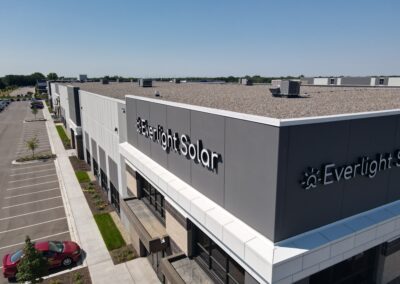STEP 1: PANELS ARE ACTIVATED BY SUNLIGHT
A layer of silicon cells, a metal frame, a glass casing wrapped by a specific coating, and wiring make up each individual panel. The panels are joined together in “arrays” (an ordered series). These arrays are placed on rooftops or in big outdoor settings for maximum effect. During daylight hours, the solar cells, also known as photovoltaic cells, absorb sunlight.
STEP 2: ELECTRICAL CURRENT IS PRODUCED BY THE CELLS
A thin semiconductor wafer comprised of two layers of silicon is contained within each solar cell. An electric field is formed when one layer is positively charged and the other is negatively charged. When sunlight contacts a photovoltaic solar cell, it energizes it, causing electrons to ‘break loose’ from atoms within the semiconductor wafer. The electric field surrounding the wafer causes those unbound electrons to move, resulting in an electrical current.
STEP 3: THE ELECTRICAL ENERGY IS CONVERTED
A solar inverter is a device that converts sunlight into electricity. SMA Solar Technology AG submitted this image.
You now have solar panels that are efficiently converting sunlight into electricity, but the electricity created is known as direct current (or DC) electricity, which is different from the alternating current (or AC) electricity that powers most homes. Fortunately, a device known as an inverter can quickly convert DC current to AC electricity. These inverters can be arranged as a single inverter for the entire system or as separate microinverters installed behind the panels in newer solar systems.
STEP 4: THE CONVERTED ELECTRICITY POWERS YOUR HOUSE.
A solar microinverter is an electronic device that converts solar energy into electrical energy.
Solar energy is transformed from DC to AC and then sent throughout your home to power your appliances via your electrical panel. Nothing in your home needs to be changed because it works in the same way as the electricity generated by your electric utility provider via the grid. Because you’re still connected to your traditional power company, you may automatically draw additional electricity from the grid to compensate for any solar shortages.
STEP 5: A NET METER MEASURES USAGE IN.
Your solar shingles or panels may not be able to capture enough sunlight to utilize for electricity on cloudy days or overnight; conversely, when no one is home during the day, they may collect surplus energy—more than you need to power your home. That’s why a meter is used to track the amount of power coming into and out of your home. Any surplus power you send back to the grid will usually earn you credits from your utility company. This is referred to as net metering.
Now that you understand the fundamentals of solar energy, you can marvel at how modern photovoltaic technology can harness the sun’s tremendous power to power a home. It isn’t rocket science, but it is certainly human inventiveness at its finest.
Are you considering solar for your home? Check out our products and services here!




